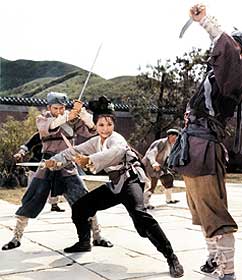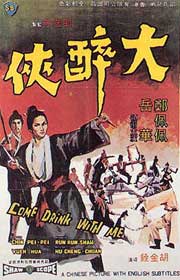 Cheng Pei Pei was only 19 years old when she starred in Come Drink with Me (Dai zyu zi, 1966), the film that would forever after identify her with swordswoman roles, & would thereafter define wuxia or kung fu historicals.
Cheng Pei Pei was only 19 years old when she starred in Come Drink with Me (Dai zyu zi, 1966), the film that would forever after identify her with swordswoman roles, & would thereafter define wuxia or kung fu historicals.
This film strives for a degree of realism at a time when Chinese swordplay films were still strongly under the influence of highly artificial opera presentations of Chinese hero tales & folklore with attendant staginess & artifice. Come Drink with Me very nearly birthed a renaissance of serious-minded martial arts films.
The renaissance was nipped in the bud as these films veered into (on the one hand) corn-pone wire-fu antics & heroic fantasy & left history & authenticism in the dust, & (on the other hand) into punch-and-block cheapies of rough-and-tumble street toughs void of King Hu's Romanticism or aestheticism, this latter shoved to the foreground throughout the world by Bruce Lee.
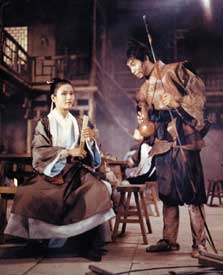 Still, even to this day, when some director attempts a serious & aesthetic martial arts epic without the more absurd antics, that director is invariably compared to King Hu, & generally found lacking a little something found in his best films, notably Come Drink with Me & A Touch of Zen (Hsia nu, 1969). Still, even to this day, when some director attempts a serious & aesthetic martial arts epic without the more absurd antics, that director is invariably compared to King Hu, & generally found lacking a little something found in his best films, notably Come Drink with Me & A Touch of Zen (Hsia nu, 1969).
King Hu wanted the characters in his films to appear truly capable of the fight. He preferred long takes that did not attempt to fool the viewer with quick edits. These players really had to be able to play out these scenes.
Cheng Pei Pei had studied martial arts intensely in the few months leading up to the filming, but she was mainly a dancer, so trained since childhood. Her understanding of choreography was probably more beneficial than kung fu training.
Realism at swordplay had not been attempted before & everyone involved had to figure out how it could be safely done. They worked out methods that became standard for action-directors to follow, & taught in acting school when training for martial arts films. But many of these now-familiar elements were never seen before Come Drink with Me.
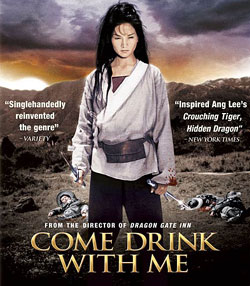 After a slaughterfest, bandits along the highway capture the governor's son to exchange for their own imprisoned leader. They've no intention of showing him any mercy, however, & even if they do get their leader back, the see no reason not to kill the young man.
After a slaughterfest, bandits along the highway capture the governor's son to exchange for their own imprisoned leader. They've no intention of showing him any mercy, however, & even if they do get their leader back, the see no reason not to kill the young man.
The bad guys are truly awful, but not in the comic book manner of too many villains to come. The killing of the child monk is brutal even for today's audience, & must have shocked the hell out of audiences in 1966.
Golden Swallow (Cheng Pei-pei) shows up to meet with Smiling Tiger (Lee Wan-chung) & discuss release of the governor's son. The captive is in fact her own brother, & she's come to save him no matter what it takes.
She's called "sir" & "he" & "kid" in the opening scenes & anyone who has not seen many examples of wuxia may suspect the subtitles are mistranslated. Alas, no. Women frequently played even outright male roles in Chinese films -- Cheng Pei-pei got the male lead in one of her earliest films,The Lotus Lamp (Bai lian deng, 1963), & there was little unsual about such casting.
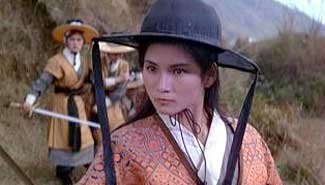 Audiences were long adjusted to the idea that a male character could be played by a man or a woman, or a woman could pose as a man within a story & nobody would notice, even if she was a teenage beauty who couldn't pass for a boy if God himself insisted. Audiences were long adjusted to the idea that a male character could be played by a man or a woman, or a woman could pose as a man within a story & nobody would notice, even if she was a teenage beauty who couldn't pass for a boy if God himself insisted.
This standard affectation of Chinese films remained very common throughout the 1970s in films like The Young Avenger (Xiao du long, 1972) in which gorgeously & utterly female Shih Tsu is temporarily mistaken for a tough young fellow; or The Golden Seal (Jin yin chou, 1971) the script for which insists Ping Wang is successfully disguised as a man, when no way is that actually occurring. The affectation continues to some degree down to today -- think Bridgette Lin butching it up as the swordsman of The Legend of the Swordsman (Xiao ao jiang hu zhi dong fang bai, 1991).
This can really detract from western audiences' sense of belief, for only occasionally does a director try to make it believable rather than just something taken for granted in these films. Considering the type & degree of realism King Hu hoped for, it's surprising he let the ever-so-beautiful character of Golden Swallow be mistaken for a young man for even a little while.
Fortunately, soon enough, everyone realizes the truth & that's over with, & what a relief to no longer be distracted by everyone's apparent blindness in mistaking one of the most beautiful women cinema has ever known for a man.
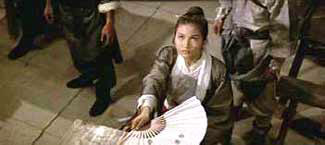 The inn sequence is not merely a classic, but a seriously defining moment for wuxia.
The inn sequence is not merely a classic, but a seriously defining moment for wuxia.
Fights in two-decker inns (with upstairs balconies to add extra dimension to the choreography) would remain forever after de rigueur for kung fu costumers.
Yet when King Hu framed this sequence, like much else in the film that would later be standard, it was not previously often seen. But inns were the public-space shopping malls of old China, & once King Hu showed how a really big fight might be orchestrated in this confined space, the "oh yeah!" light went on over the head of every other wuxia director.
In this sequence coins, chopsticks & a fan are used by Golden Swallow to convey to a group of threatening men how skilled she is.
Pei-pei also has a subtle little shift of gaze that was to become her trademark. She can be sitting or standing quietly in an inn or along a path & if she takes a quick look, once, to the left, you gotta suspect bad guys in the vicinity are about to bite the dust.
Watch for this little shift of gaze in several of her films that followed, including her great swordswoman role in The Lady Hermit (Zhong kui niang zi, 1971).
During the inn sequence, watch also for the scar-faced swordsman. He's action director Han Ying-chieh getting a cameo of his own!
Everyone had input into the choreography, much of which was stuff nobody had ever tried before, but the guys who held it together as one big vision were King Hu himself, & Han Ying-chieh, with assistance from a young Sammo Hung who would one day soon be among Hong Kong's most famous kung fu character actors.
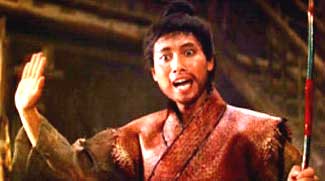 Obviously it's not the easiest thing for an actor to be noticed when Cheng Pei-pei so commands the screen.
Obviously it's not the easiest thing for an actor to be noticed when Cheng Pei-pei so commands the screen.
Yet Yueh Hua as Drunken Cat manages to be quite the scene-stealer, more than holding his own as a thrilling character, though it's a mite unfair that he gets to play drunk and be followed about by orphans to make his bigger than life character even more colorful.
King Hu seems to have had some doubts that Yeueh Hua had sufficient strength to pull off the idea that he's an even stronger fighter than Golden Swallow. Hu had Hua's lines replaced by someone with a more commanding voice, & it has been traditional ever since to insist that without all sorts of director-controlled assistance, Yueh Hua would have vanished behind Cheng Pei-pei's skirts.
Some critics go so far as to insist he was insufficient for the role even as presented. I'm not convinced he needed all the assists to pull it off, but we'll never know that for certain. I am sure one of the reasons the film is such a classic is because he did make an enormous impression, & turns in a phenomenal performance through facial expressions & body language & conviction in a duel.
Although he's a scruffy beggar, Drunken Cat takes care of numerous homeless children. He has a wonderful begging-song with the children serving as chorus so they can earn enough for meat-buns all round, except for Drunken Cat, who'd rather have booze.
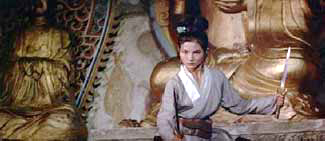 The Drunken Cat character has often been credited as having provided the roots of a new style of Movie Kung-fu beginning with Jackie Chan's Drunken Monkey (Jui kuen, 1978). Jackie himself admits to inspiration from Come Drink with Me.
The Drunken Cat character has often been credited as having provided the roots of a new style of Movie Kung-fu beginning with Jackie Chan's Drunken Monkey (Jui kuen, 1978). Jackie himself admits to inspiration from Come Drink with Me.
But the inspiration couldn't've been for a drunken fight style per se, because Drunken Cat is either only pretending to be drunk most of the time (which seems likeliest) or when need arises he just pulls it all together & fights very well. Nothing staggery or comical goes with his fighting style, despite that he's otherwise an amusing guy.
Still, there's an insinuation, not shown to be the real truth, that Drunken Cat is a better fighter when drunk. It's a claim he makes, but much of the time he's just having a joke over on the people around him, pretending to be a whimsical fool without fighting talent.
I can well imagine someone like Jackie Chan, who was always drawn toward the idea of funny kung fu, taking the next logical step with a character who really needed to go on a bender before fighting his best.
In this film however, Drunken Cat's primary fighting method is a reflection of the decent & caring nature of his character. He does not like to kill, & so uses a pole-fighting technique to redirect foes' sword strokes, & if they're evil enough scoundrels to merit death, he'll redirect their strokes to kill each other.
Drunken Cat has a mysterious chi power that is a complete break from King Hu's semi-realism, a method not yet fully mastered (though he's getting closer) by which a veritable tornado exudes from his palm. Eventually he'll get this right for his big finale.
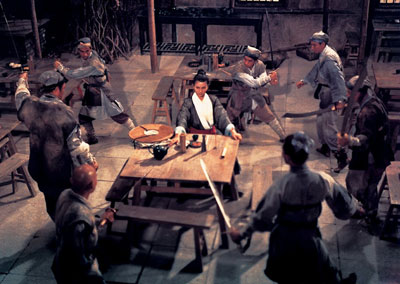 Golden Swallow's second big set piece for action is her battle before the Buddha statue in the temple, using two short swords smuggled in her boots.
Golden Swallow's second big set piece for action is her battle before the Buddha statue in the temple, using two short swords smuggled in her boots.
Her primary goal is to save her brother; her secondary goal is to arrest the bad guys though she'll settle for cutting them to ribbons.
Her primary opponent is Jade-faced Tiger (Hung Lieh Chen), a devilish, pale, dandified villain, & beyond cruel. Golden Swallow is nonchalant in the battle, her expression ranging from intent, to indifferent, to fierce.
When it boils down to a one-on-one fight with Jade-faced Tiger, their duel exemplifies King Hu's capacity to use action as a reflection of character. Each character fights according to their entire nature, not according to what any action choreographer might've had any character in any film perform.
There's a bigger underlying villain, however, who arrives late to the story. He's the evil Abbot Liao Kung (Yeung Chi-hing). He's long been searching for a certain kung-fu master, Fan Ta-pei, rumored to be posing as a mere drunk. Well, it's no mystery to us who that "drunken hero" might be!
As if we haven't been given enough praiseworthy & thrilling in this story, there's additionally a troop of amazons who help protect Golden Swallow's brother Chang during the climactic battle. The abbott vs beggar duel is one of the best in the film because rich in humanity & valor, not just violence for the sake of violence.
Continue to next Cheng Pei Pei film:
Dragon Creek 1967
copyright © by Paghat the Ratgirl
|
